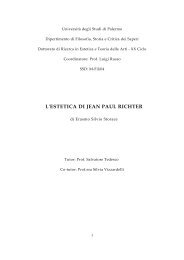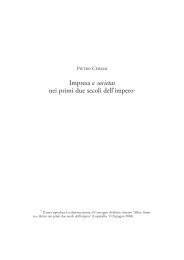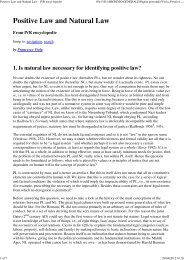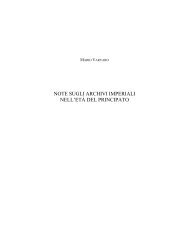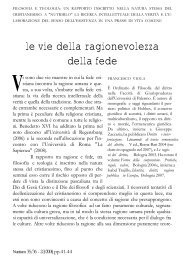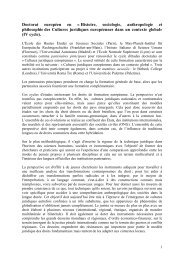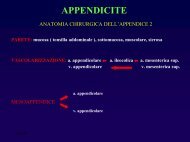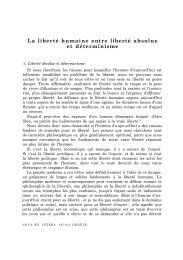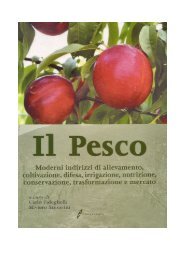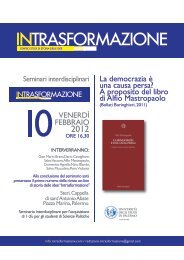F. TERRANOVA, Osservazioni su Gai 2.108 pp. 281 - Università di ...
F. TERRANOVA, Osservazioni su Gai 2.108 pp. 281 - Università di ...
F. TERRANOVA, Osservazioni su Gai 2.108 pp. 281 - Università di ...
You also want an ePaper? Increase the reach of your titles
YUMPU automatically turns print PDFs into web optimized ePapers that Google loves.
et fundamentum totius testamenti e il familiae emptor non viene più percepito<br />
come parte dell’atto, 81 emerge il problema relativo alla possibilità<br />
<strong>di</strong> impiegare l’erede come testimone, poiché ri<strong>su</strong>lta chiaramente<br />
che questi è, a tutti gli effetti, portatore del medesimo concreto interesse<br />
al compimento dell’atto che aveva avuto, in precedenza, il familiae<br />
emptor. Queste ultime considerazioni sono alla base, verosimilmente,<br />
dello svilu<strong>pp</strong>arsi <strong>di</strong> un orientamento giurisprudenziale in contrasto<br />
con la facoltà <strong>di</strong> iure adhibere come testimoni i propri ere<strong>di</strong> cui,<br />
secondo noi, si allude in <strong>Gai</strong> <strong>2.108</strong>, e <strong>di</strong> cui si trova traccia anche in I.<br />
2.10.10:<br />
<strong>Gai</strong> <strong>2.108</strong>: ...Sed tamen, quod ad heredem pertinet quique in eius<br />
potestate est cuiu<strong>su</strong>e is in potestate erit, minime hoc iure uti debemus.<br />
I. 2.10.10: ...licet hi, qui id permittebant, hoc iure minime abuti debere<br />
eos <strong>su</strong>adebant rell. 82<br />
In base al modo in cui l’inciso è nei due passi formulato, ci sembra<br />
plausibile <strong>su</strong><strong>pp</strong>orre che minime venga adoperato da <strong>Gai</strong>o con il significato<br />
<strong>di</strong> ‘al minimo’, a <strong>di</strong>fferenza che nel manuale imperiale, ove<br />
verosimilmente ha valore <strong>di</strong> negazione, e può essere, quin<strong>di</strong>, reso come<br />
‘non, affatto’. 83 A sostegno <strong>di</strong> ciò basti notare che gli antecessores<br />
getto <strong>di</strong> <strong>di</strong>sporre delle proprie sostanze per il tempo dopo la <strong>su</strong>a morte. Una conferma a<br />
ciò si rinviene in Tit. Ulp. 20.9: In testamento, quod per aes et libram fit, duae res aguntur,<br />
familiae mancipatio et nuncupatio testamenti rell.<br />
81 È ragionevole ipotizzare che i due aspetti si siano andati trasformando <strong>di</strong> pari passo.<br />
La metamorfosi del familiae emptor in un ‘terzo’ estraneo all’atto, fu poi, com’è noto, accelerata<br />
in seguito alla concessione da parte del pretore della bonorum possessio secundum tabulas.<br />
Cfr. I. 2.10.2: ...iure enim honorario nulla emancipatio desiderabatur, sed septem testium signa<br />
<strong>su</strong>fficiebant, cum iure civili signa testium non erant necessaria. Com’è ammesso unanimemente<br />
dagli stu<strong>di</strong>osi, «il numero <strong>di</strong> sette richiesto per i testimoni ricalcava forme proprie del testamento<br />
per aes et libram, per il quale era prescritto... l’intervento <strong>di</strong> cinque testimoni, del<br />
libripens e del familiae emptor». Così M. MARRONE, Istituzioni <strong>di</strong> <strong>di</strong>ritto romano 3 , cit., 613.<br />
Cfr., per tutti, C.G. BRUNS, Die sieben Zeugen des römischen Rechts, cit., 123.<br />
82 Cfr. PT. 2.10.10: ...parÇnouncrÖnaitoùj<strong>di</strong>atiJeménoujmÕ ÞpokecrÖsJaitØ<br />
dedomén+toiaút+paÚ×hsí=ktl. (Reitz: ... admonebant testatores, ne data<br />
hac licentia abuterentur rell.)<br />
83 Si noti, per inciso, che la locuzione in questione viene adoperata nel manuale gaiano<br />
in quest’unico luogo. Così anche F. KNIEP, <strong>Gai</strong> Institutionum, Commentarius secundus:<br />
§§ 97-289 (Testamentarisches Erbrecht), cit., 6 nt. 3: «Es fragt sich nur: ob <strong>di</strong>ese Anfügung<br />
314



